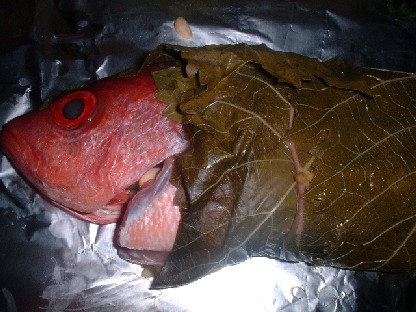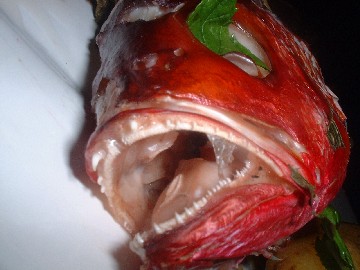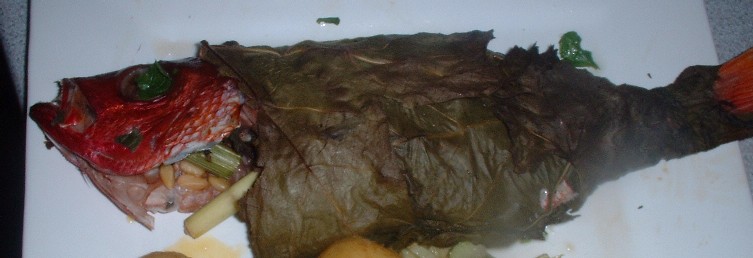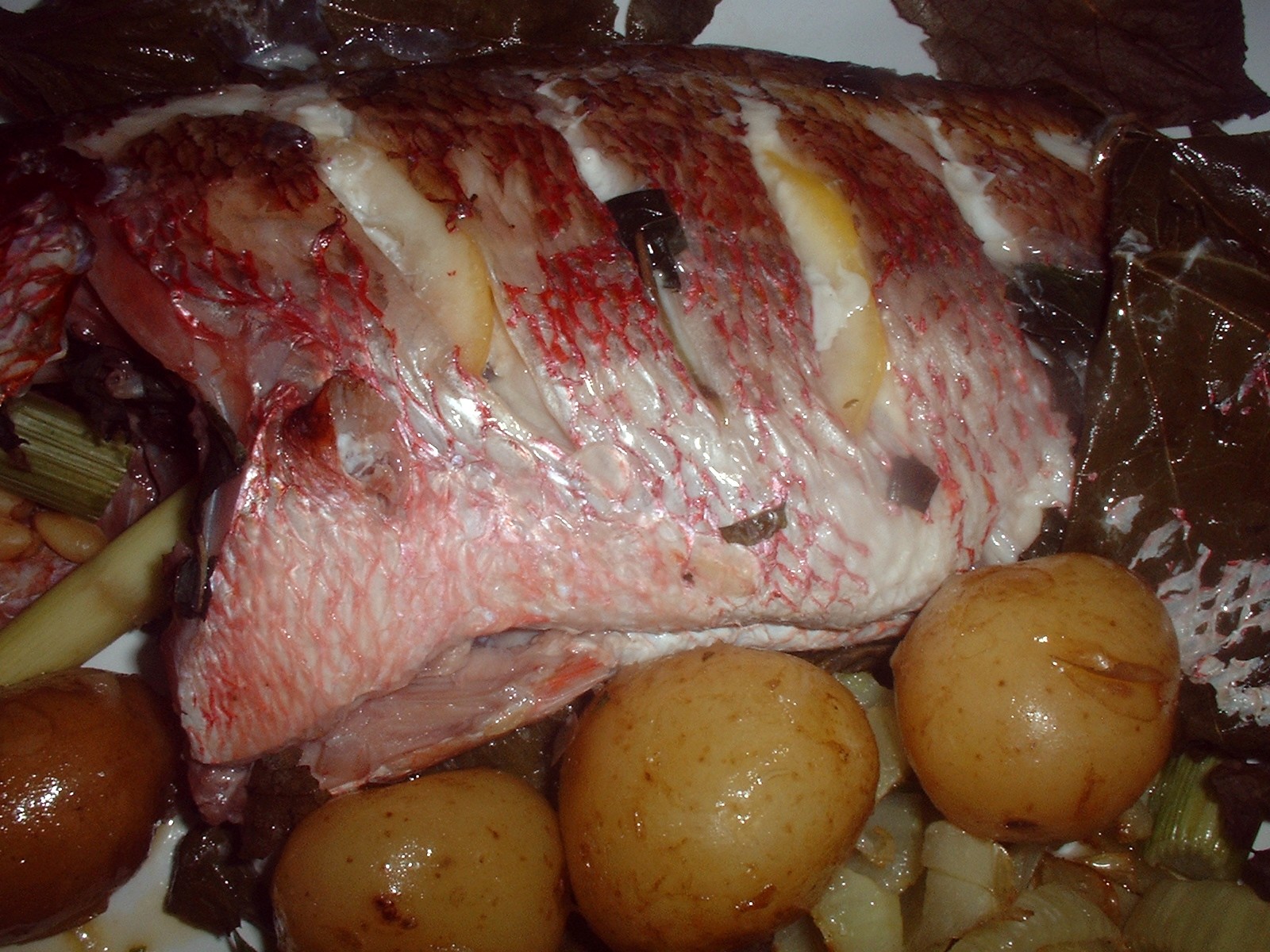
Last Saturday I was given some fresh vine leaves to use. I felt very lucky. I don't know if you can buy fresh leaves anywhere and I'm not too keen on the tinned ones. I wanted to use them to do something interesting but I'd only ever seen them used in dolmades.
So after scouring the internet and some cookery books I came across another use for these leaves: baking fish.
Apparently there are recipes for this kind of thing dating back to the Roman occupation. A whole fish is wrapped in vine leaves and then baked. I assume the vine leaves are supposed to keep the fish moist! I had a red snapper in the fridge that seemed perfect to try this out on.

I think snappers look quite cute. Especially when they are wrapped up cosily in a vine leaf blanket. You wouldn't think they were carnivorous fish, would you?

Then again, those are some sharp looking teeth!
To prepare my snapper, I cut three slits in the skin on each side and stuffed in some lemon zest and mint. I then rubbed the fish inside and out with a mixture of lemon juice, crushed garlic and chopped mint. A few lemon slices and a piece of bruised lemongrass went into the cavity too. The vine leaves were blanched in boiling water for a few seconds to soften them up and then used to wrap up the snapper. I left it to sit and absorb the flavours for 20 minutes before baking it at 200C for about 20 minutes. It came out like this.

The lemon flavour had really permeated the fish. The garlic and mint were more subtle but still noticeable. The vine leaves had certainly done their job in keeping the fish moist. Snapper has a lovely creamy texture. Like a lot of white fish, it doesn't have huge amounts of flavour but it was good after being marinated.
The downside to snapper, as with any whole fish, is the bones. The backbone was quite easy to remove but there were all kinds of little bits and pieces that were harder to get rid of. Once they were gone, the fish was delicious!
The vine leaves dried out more than they should have done. I think this was because of the way our electric oven is designed. It's not like a proper oven but a grill with multiple levels. If anyone tries/has tried this in a proper oven, let me know. I'd like to hear how it turned out! Details for the snapper in vine leaves are here.
Mr Snapper was served with some baby new potatoes and stir fried crunchy fennel. When the leaves came off, you could see the lovely red skin, which makes it look so appetizing.

I'd like to try making snapper again, perhaps baking it in a salt dough crust like this, but at £6 per fish, it is going to be a long time before I get one again! It's nice but not THAT nice!
Last Saturday I was given some fresh vine leaves to use. I felt very lucky. I don't know if you can buy fresh leaves anywhere and I'm not too keen on the tinned ones. I wanted to use them to do something interesting but I'd only ever seen them used in dolmades.
So after scouring the internet and some cookery books I came across another use for these leaves: baking fish.
Apparently there are recipes for this kind of thing dating back to the Roman occupation. A whole fish is wrapped in vine leaves and then baked. I assume the vine leaves are supposed to keep the fish moist! I had a red snapper in the fridge that seemed perfect to try this out on.
I think snappers look quite cute. Especially when they are wrapped up cosily in a vine leaf blanket. You wouldn't think they were carnivorous fish, would you?
Then again, those are some sharp looking teeth!
To prepare my snapper, I cut three slits in the skin on each side and stuffed in some lemon zest and mint. I then rubbed the fish inside and out with a mixture of lemon juice, crushed garlic and chopped mint. A few lemon slices and a piece of bruised lemongrass went into the cavity too. The vine leaves were blanched in boiling water for a few seconds to soften them up and then used to wrap up the snapper. I left it to sit and absorb the flavours for 20 minutes before baking it at 200C for about 20 minutes. It came out like this.
The lemon flavour had really permeated the fish. The garlic and mint were more subtle but still noticeable. The vine leaves had certainly done their job in keeping the fish moist. Snapper has a lovely creamy texture. Like a lot of white fish, it doesn't have huge amounts of flavour but it was good after being marinated.
The downside to snapper, as with any whole fish, is the bones. The backbone was quite easy to remove but there were all kinds of little bits and pieces that were harder to get rid of. Once they were gone, the fish was delicious!
The vine leaves dried out more than they should have done. I think this was because of the way our electric oven is designed. It's not like a proper oven but a grill with multiple levels. If anyone tries/has tried this in a proper oven, let me know. I'd like to hear how it turned out! Details for the snapper in vine leaves are here.
Mr Snapper was served with some baby new potatoes and stir fried crunchy fennel. When the leaves came off, you could see the lovely red skin, which makes it look so appetizing.
I'd like to try making snapper again, perhaps baking it in a salt dough crust like this, but at £6 per fish, it is going to be a long time before I get one again! It's nice but not THAT nice!


